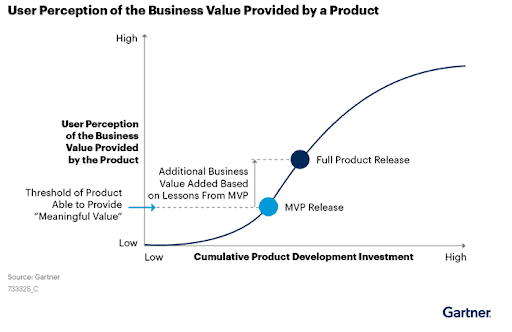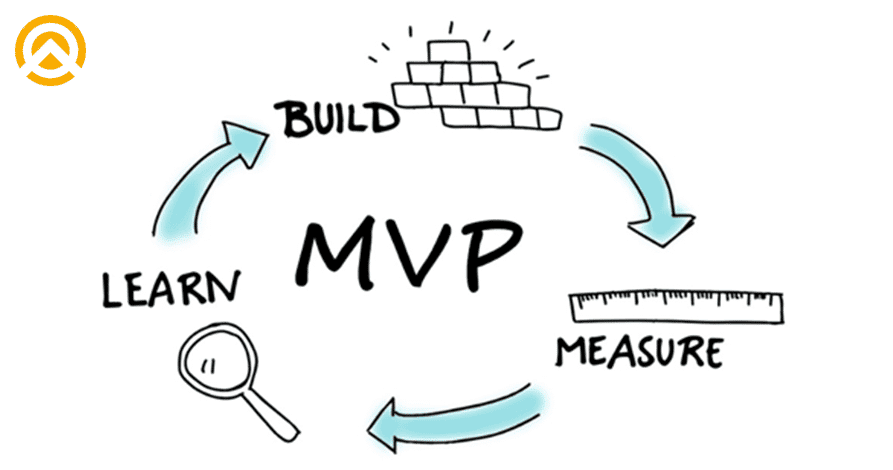The Backbone of Successful MVPs and Product Iterations
In the current times, the establishment of any business would not require plenty of resources. If you have enough skill sets and a small amount of money then your business idea can be turned into reality. Imagine if you have a ground-breaking digital or app product idea that can completely change the current situation. Such as living criteria, working, and other criteria of providing ease. For turning your mind blowing idea into reality one can look forward to adapting the Minimum Viable Product (MVP) approach.
This completely works as a game changer and provides many benefits for newly started businesses. MVPs are defined as the initial versions of an application or digital platform. That requires you to add only mandatory functionality with minimum cost advanced technology provides benefits. These are core functionality involving product, effective customer relationship management, updates with constant functionality, and reduced development cost. In the same context, the research data by Gartner presents some valuable aspects.

As shown in the figure above the integration of the MVP approach works as a threshold asset. That makes sure that you start your business with effective growth. This indicates that any business idea that is willing to start from ground zero then MVP app development leads to additional business value and many other benefits. There are many contributing factors to the development of MVP-based platforms and customer feedback is considered the most important one.
No doubt MVP is the technology that can provide ease to various startups in which early customers play a major role. This blog is all about how customer feedback impacts the growth of MVP-aided products. Highlighting the role of user feedback for successful MVP app development and step-by-step product iterations. Give this a quick read and adapt the practice of saving cost.
The importance of user feedback in MVP development
User feedback is the lifeblood of any MVP app development company. It serves as a compass guiding product refinement by uncovering user needs, preferences, and pain points. This iterative process ensures that the MVP evolves in alignment with user expectations and market demands. Increasing its likelihood of achieving product-market fit.
1. Verifying Assumptions
MVPs are typically constructed based on assumptions regarding user needs, preferences, and pain points. User feedback serves to confirm or question these assumptions. By collecting authentic data from users, developers can ensure they are heading in the right direction and creating a product that effectively tackles users’ issues.
2. Identification of Critical Points
User feedback is a valuable resource for discovering the challenges users face while engaging with the MVP. These challenges may pertain to usability, functionality, or unforeseen issues. Identifying these pain points in the early stages allows developers to rectify them in subsequent iterations, thus improving the overall user experience.
3. Prioritization of Features
In the context of an MVP, resources are scarce, and time is a precious commodity. User feedback is a guiding light, illuminating the essential features that resonate most with users, while also shedding light on less critical components that can be safely deferred. This strategic approach empowers efficient resource allocation, ensuring that development efforts are channeled toward what truly resonates with the target audience, thereby optimizing the MVP’s value and appeal.
4. Formation of User-Centric Approach
User feedback serves as the anchor that keeps the mobile app development process firmly rooted in the realm of user needs and desires. It acts as the compass guiding the product’s growth to stay in harmony with user preferences. This synergy culminates in the development of user-centric products that have a higher likelihood of thriving in the market, driven by a deep understanding of user expectations.
5. Integrating Continuous Improvement
MVP software development unfolds as an iterative journey, with user feedback as its propelling engine. Through a systematic analysis of feedback and subsequent incremental enhancements, the product’s evolution seamlessly aligns with user expectations and the ever-changing market landscape. This ongoing refinement is a pivotal element in reaching the coveted state of product-market fit.
Implementing the Concept of MVP User Feedback Loop

The user feedback loop is a vital component of any successful MVP product development consultant. It involves a continuous cycle of releasing a Minimum Viable Product (MVP), collecting user feedback, and using this feedback to improve and refine the product. This iterative approach ensures that the product aligns closely with user needs and market demands.
- Initial Market Release
The initial market release is the first step in the MVP development process. It involves launching a basic version of the product that includes its core features. This release provides an opportunity to gauge the initial response of users and the market.
- Feedback Collection
Feedback collection is the process of actively seeking input from users who interact with the MVP. This feedback can be gathered through surveys, user testing, analytics, and user engagement metrics. It helps in understanding how users perceive the product and what issues they encounter.
- Feedback Analysis
Once user feedback is collected, the next step is to analyze it thoroughly. This involves identifying trends, common pain points, and areas where the product excels. Feedback analysis is crucial for making informed decisions about what aspects of the MVP need improvement.
- Prioritization
Prioritization is the act of determining which issues or features should be addressed first based on the feedback and analysis. It’s essential to focus on the most critical and impactful changes that will enhance the user experience and align with the product’s goals.
- Iterative Development
Iterative development is the process of making incremental changes and improvements to the MVP based on the prioritized feedback. This step helps refine the product and steer it in the right direction, ensuring that it becomes more valuable and user-centric with each iteration.
- The Concept of Repeat
The concept of repeat embodies the idea that the MVP user feedback loop is not a one-time activity. It’s an ongoing process that repeats throughout the product’s lifecycle. As users’ needs and market dynamics evolve, so should the product. This iterative approach ensures that the product remains relevant and competitive.
Read more: Prototype vs MVP vs PoC (Proof of Concept): What to Choose?
Application Strategies of User Feedback in MVP
User feedback is the cornerstone of successful MVP development. It provides critical insights into user needs, preferences, and pain points. By incorporating user feedback, developers can fine-tune their product, ensuring it aligns with market demands and user expectations, ultimately leading to a more successful and user-centric MVP.
1. Analytics and User Tracking
Utilizing analytics tools empowers developers to monitor user interactions within the MVP. This data unveils critical insights into user behavior, such as the most frequented features, user drop-off points, and the time users allocate to various sections of the product. By comprehensively understanding how users engage with the MVP, developers can make informed decisions to enhance its performance and user experience. This data-driven approach not only ensures that the product aligns with user preferences but also aids in optimizing its design and functionality based on real-world usage patterns, ultimately leading to a more successful and user-centric MVP.
2. User Testing
This is a vital method for obtaining direct insights into how users interact with the MVP. It involves observing users as they navigate the product, uncovering pain points, and identifying areas of value. User testing can be carried out either in-person or remotely, offering flexibility to suit different circumstances. During these sessions, participants perform specific tasks within the MVP, while researchers or product teams observe their actions and gather feedback. In-person testing allows for immediate interaction, while remote testing accommodates a broader participant base. The insights gained from user testing are crucial for refining the MVP, making it more user-centric and aligned with market demands.
3. Support Channels
Keeping an eye on customer support channels, encompassing emails, chats, and service calls, offers a valuable source of unsolicited user feedback. Users frequently contact support teams when they face challenges or wish to share their ideas. This unsolicited feedback can be a goldmine for pinpointing pain points and areas in need of enhancement within the MVP. It provides unfiltered insights into real user experiences and unearths issues that users may not have shared through formal feedback channels. Harnessing this data aids in fine-tuning the product, ensuring it aligns better with user expectations and delivers an improved overall experience.
4. Feedback Loops
Creating a well-defined feedback loop within the product is imperative. Incorporate elements like in-app feedback forms or buttons, enabling users to report problems and propose enhancements directly. This not only simplifies the process for users to share their thoughts but also conveys a commitment to actively listening to their input. Such features foster a sense of user engagement and involvement in the product’s evolution, reinforcing a user-centric approach. This direct line of communication not only facilitates the collection of valuable insights but also nurtures a positive relationship with users, enhancing their trust and satisfaction with the MVP.
5. Surveys and Questionnaire
This technique offers an efficient means to collect structured feedback from a wide user audience. They can be distributed through email, integrated within the product interface, or shared via social media. These tools can be customized to focus on particular facets of the MVP, such as its usability, features, or overall user satisfaction. Their scalability and structured format make surveys and questionnaires valuable for aggregating insights from a broad user base, providing quantitative data that complements qualitative methods like user testing. This data aids in making data-driven decisions for MVP improvements and ensuring it meets user expectations effectively.
Conclusive Outlines
In the realm of successful MVPs and product iterations, the role of MVP Advancement is paramount. It serves as the cornerstone for making data-driven decisions that ensure product success by leveraging user feedback and responding to market demand. This approach offers tailored insights for diverse product scenarios. With an ever-increasing emphasis on evidence-based development and optimization, the tech industry has witnessed visionary developers and forward-thinking organizations working diligently to enhance their products through empirical analysis. Despite facing initial challenges, many have emerged as pioneers in the field of MVP advancement strategies. In today’s continually evolving landscape of digital products, the adoption of intelligent data-driven strategies is more accessible, enabling companies to adapt to modern market demands.
Amplework, a prominent player in the mobile app development industry, boasting over 5+ years of expertise, demonstrates excellence in this realm. Our committed team consistently exceeds client expectations, establishing a reputation for dependability. We have reached noteworthy achievements, contributing to the generation of over $200 million in revenue for diverse organizations. Visit our website to explore our outstanding MVP development services. Join forces with Amplework to initiate a transformative voyage towards data-driven decision-making that fosters product success and enhances your product’s quality and user satisfaction.
Read More:- Social Media Integration


 sales@amplework.com
sales@amplework.com
 (+91) 9636-962-228
(+91) 9636-962-228





